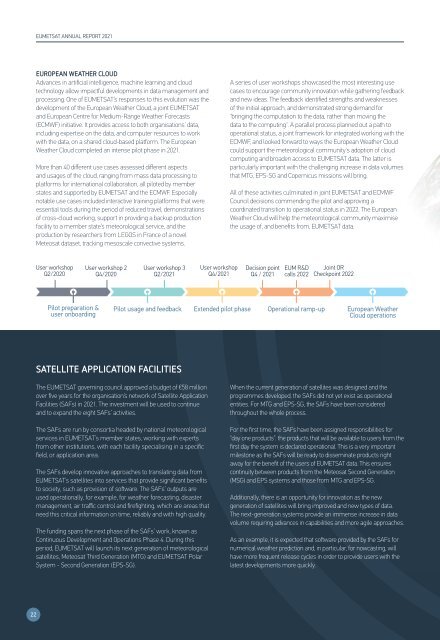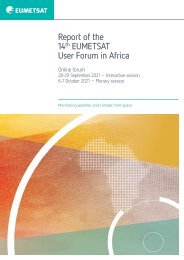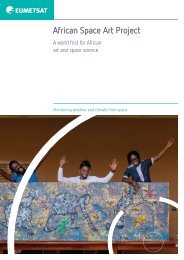EUMETSAT Annual Report 2021
Create successful ePaper yourself
Turn your PDF publications into a flip-book with our unique Google optimized e-Paper software.
<strong>EUMETSAT</strong> ANNUAL REPORT <strong>2021</strong><br />
EUROPEAN WEATHER CLOUD<br />
Advances in artificial intelligence, machine learning and cloud<br />
technology allow impactful developments in data management and<br />
processing. One of <strong>EUMETSAT</strong>’s responses to this evolution was the<br />
development of the European Weather Cloud, a joint <strong>EUMETSAT</strong><br />
and European Centre for Medium-Range Weather Forecasts<br />
(ECMWF) initiative. It provides access to both organisations’ data,<br />
including expertise on the data, and computer resources to work<br />
with the data, on a shared cloud-based platform. The European<br />
Weather Cloud completed an intense pilot phase in <strong>2021</strong>.<br />
More than 40 different use cases assessed different aspects<br />
and usages of the cloud, ranging from mass data processing to<br />
platforms for international collaboration, all piloted by member<br />
states and supported by <strong>EUMETSAT</strong> and the ECMWF. Especially<br />
notable use cases included interactive training platforms that were<br />
essential tools during the period of reduced travel, demonstrations<br />
of cross-cloud working, support in providing a backup production<br />
facility to a member state’s meteorological service, and the<br />
production by researchers from LEGOS in France of a novel<br />
Meteosat dataset, tracking mesoscale convective systems.<br />
A series of user workshops showcased the most interesting use<br />
cases to encourage community innovation while gathering feedback<br />
and new ideas. The feedback identified strengths and weaknesses<br />
of the initial approach, and demonstrated strong demand for<br />
"bringing the computation to the data, rather than moving the<br />
data to the computing". A parallel process planned out a path to<br />
operational status, a joint framework for integrated working with the<br />
ECMWF, and looked forward to ways the European Weather Cloud<br />
could support the meteorological community's adoption of cloud<br />
computing and broaden access to <strong>EUMETSAT</strong> data. The latter is<br />
particularly important with the challenging increase in data volumes<br />
that MTG, EPS-SG and Copernicus missions will bring.<br />
All of these activities culminated in joint <strong>EUMETSAT</strong> and ECMWF<br />
Council decisions commending the pilot and approving a<br />
coordinated transition to operational status in 2022. The European<br />
Weather Cloud will help the meteorological community maximise<br />
the usage of, and benefits from, <strong>EUMETSAT</strong> data.<br />
User workshop<br />
Q2/2020<br />
User workshop 2<br />
Q4/2020<br />
User workshop 3<br />
Q2/<strong>2021</strong><br />
User workshop<br />
Q4/<strong>2021</strong><br />
Decision point<br />
Q4 / <strong>2021</strong><br />
EUM R&D<br />
calls 2022<br />
Joint OR<br />
Checkpoint 2022<br />
Pilot preparation &<br />
user onboarding<br />
Pilot usage and feedback Extended pilot phase Operational ramp-up European Weather<br />
Cloud operations<br />
SATELLITE APPLICATION FACILITIES<br />
The <strong>EUMETSAT</strong> governing council approved a budget of €58 million<br />
over five years for the organisation’s network of Satellite Application<br />
Facilities (SAFs) in <strong>2021</strong>. The investment will be used to continue<br />
and to expand the eight SAFs’ activities.<br />
The SAFs are run by consortia headed by national meteorological<br />
services in <strong>EUMETSAT</strong>’s member states, working with experts<br />
from other institutions, with each facility specialising in a specific<br />
field, or application area.<br />
The SAFs develop innovative approaches to translating data from<br />
<strong>EUMETSAT</strong>’s satellites into services that provide significant benefits<br />
to society, such as provision of software. The SAFs’ outputs are<br />
used operationally, for example, for weather forecasting, disaster<br />
management, air traffic control and firefighting, which are areas that<br />
need this critical information on time, reliably and with high quality.<br />
The funding spans the next phase of the SAFs’ work, known as<br />
Continuous Development and Operations Phase 4. During this<br />
period, <strong>EUMETSAT</strong> will launch its next generation of meteorological<br />
satellites, Meteosat Third Generation (MTG) and <strong>EUMETSAT</strong> Polar<br />
System - Second Generation (EPS-SG).<br />
When the current generation of satellites was designed and the<br />
programmes developed, the SAFs did not yet exist as operational<br />
entities. For MTG and EPS-SG, the SAFs have been considered<br />
throughout the whole process.<br />
For the first time, the SAFs have been assigned responsibilities for<br />
“day one products”: the products that will be available to users from the<br />
first day the system is declared operational. This is a very important<br />
milestone as the SAFs will be ready to disseminate products right<br />
away for the benefit of the users of <strong>EUMETSAT</strong> data. This ensures<br />
continuity between products from the Meteosat Second Generation<br />
(MSG) and EPS systems and those from MTG and EPS-SG.<br />
Additionally, there is an opportunity for innovation as the new<br />
generation of satellites will bring improved and new types of data.<br />
The next-generation systems provide an immense increase in data<br />
volume requiring advances in capabilities and more agile approaches.<br />
As an example, it is expected that software provided by the SAFs for<br />
numerical weather prediction and, in particular, for nowcasting, will<br />
have more frequent release cycles in order to provide users with the<br />
latest developments more quickly.<br />
22









